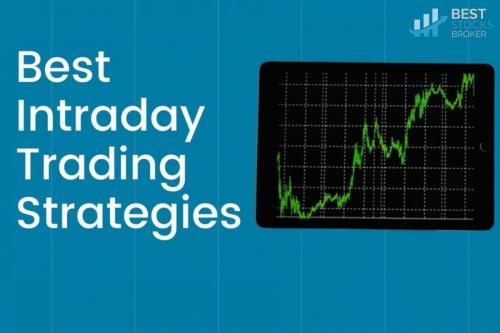Best Intraday Trading Strategies & Tips for Beginners

Are you a beginner in the world of trading, looking to make
quick profits within a single day? If so, then intraday trading might be just
the right strategy for you! Intraday trading involves buying and selling
securities within the same trading day, aiming to capture short-term price
movements. But how can beginners navigate this fast-paced and volatile market
successfully? Fear not, because we have compiled a list of the best intraday
trading strategies and tips specifically tailored for newcomers like
yourself. So grab your pen and paper, because it's time to dive into the
exciting world of intraday trading strategies!
5 Best Intraday
Trading Strategies – 2023
1. Momentum Trading:
This strategy involves identifying stocks that are experiencing significant
price movements in a particular direction and capitalizing on those trends.
Traders using this strategy will enter trades when they see strong momentum
building up, aiming to ride the wave and exit before it loses steam.
2. Breakout Trading:
In breakout trading, traders look for stocks that are breaking out of a defined
range or pattern. They wait for the stock price to break through a key
resistance level or support level, indicating a potential move in one
direction. By entering trades at the breakout point, traders can take advantage
of the ensuing price movement.
3. Scalping: This
strategy focuses on making multiple small profits throughout the day by quickly
entering and exiting trades. Scalpers aim to capture small price fluctuations
within tight ranges, taking advantage of high liquidity and frequent market
movements.
4. Range Trading:
Range trading involves identifying stocks that are stuck within a specific
range between support and resistance levels. Traders using this strategy will
buy near support levels and sell near resistance levels, profiting from
repetitive patterns as prices oscillate within the established range.
5. News-based Trading:
With news-based trading, traders capitalize on market opportunities created by
significant news events or economic releases that can cause sudden shifts in
stock prices. By staying informed about upcoming announcements and their
potential impact on specific securities, traders can make well-timed trades
based on the anticipated market reaction.
Remember that no single intraday
trading strategy guarantees success every time; it's crucial to adapt your
approach based on current market conditions and risk tolerance levels.
What Is Intraday
Trading?
Intraday trading, also known as day trading, is a popular
form of trading in the stock market where traders buy and sell stocks within
the same trading day. Unlike long-term investing, which involves holding onto
stocks for an extended period of time, intraday traders aim to take advantage
of short-term price fluctuations.
The main goal of intraday
trading is to make profits by capitalizing on small price movements.
Traders analyze charts and technical indicators to identify potential entry and
exit points for their trades. They rely heavily on technical analysis rather
than fundamental analysis to make quick decisions.
One key characteristic of intraday trading is that all
positions are closed before the end of the market day. This eliminates
overnight exposure to market risks such as unexpected news or events that can
impact stock prices.
Intraday traders often use leverage or margin accounts
provided by brokerage firms to amplify their buying power. However, it's
important to note that this strategy can increase both potential gains and
losses.
Successful intraday traders have a disciplined approach and
follow well-defined strategies. They constantly monitor the markets, manage
risk effectively, and have clear entry and exit rules in place.
Intraday trading requires careful planning, skillful
execution, and continuous monitoring of market conditions. It can be highly
rewarding for those who are dedicated enough to learn its nuances but should be
approached with caution by beginners due to its inherent risks.
Intraday Trading Tips
1. Set Clear Goals:
Before you start your intraday trading journey, it's crucial to set clear goals
for yourself. Determine how much profit you aim to make and the level of risk
you are comfortable with.
2. Choose Liquid Stocks:
Opt for stocks that have high trading volumes as they offer better liquidity.
This ensures that you can easily buy or sell shares at desired prices without
affecting the market price significantly.
3. Use Stop Loss
Orders: Implementing stop loss orders is a smart move to protect yourself
from significant losses. It automatically sells your shares if their price
falls below a predetermined level, limiting your potential losses.
4. Stay Informed: Keep
up-to-date with market news, trends, and company announcements that may impact
stock prices. This information will help you make informed trading decisions.
5. Practice Risk
Management: Never invest more than what you can afford to lose in intraday
trading. Diversify your portfolio by investing in different sectors and avoid
putting all your eggs in one basket.
6. Trade with
Discipline: Stick to your strategy and avoid making impulsive trades based
on emotions or short-term fluctuations in stock prices.
7. Learn from Your
Mistakes: Reflect on each trade and analyze both profitable and losing
one’s objectively to learn from mistakes and improve your strategies over time.
Remember, successful
intraday trading requires patience, discipline, continuous learning, and
adaptability to changing market conditions.
FAQs
Have some burning questions about intraday trading
strategies? Don't worry, we've got you covered. Here are a few common FAQs to
help clear up any confusion:
1. Can I trade in
multiple stocks during a single day?
Yes, you can! Intraday trading allows traders to buy and
sell multiple stocks within the same trading session. However, keep in mind
that it's important to have a well-defined strategy and stay updated with
market trends.
2. How much capital
do I need to start intraday trading?
The capital required for intraday trading varies from person
to person. It depends on factors such as your risk appetite, the number of
trades you plan to make, and the margin requirements set by your broker.
3. Are there any
specific timeframes for executing trades?
While there are no fixed timeframes for executing trades,
many traders prefer early morning or late afternoon sessions when market
volatility tends to be higher. However, it ultimately depends on your preferred
strategy and personal schedule.
4. What is stop-loss
order and how does it work?
A stop-loss order is an essential tool used by traders to
limit potential losses in case a trade goes against them. It sets a
predetermined price at which the trader wants their position automatically
closed out if the market moves unfavorably.
5. Is technical
analysis necessary for successful intraday trading?
While technical analysis can be helpful in identifying
patterns and trends in stock prices, it is not mandatory for successful
intraday trading. Some traders rely more on fundamental analysis or other
indicators like volume or news events.
Remember that these FAQs only scratch the surface of what
you need to know about intraday trading strategies. It's always advisable to
educate yourself thoroughly before diving into this fast-paced world!
Post Your Ad Here



Comments (1)
Awesome POWER Duplic...10
VIRTUAL Employment INDUSTRY
News Events! It's always advisable to educate yourself thoroughly before diving into this fast-paced world
1. Can I trade in multiple stocks during a single day?
Yes, you can! Intraday trading allows traders to buy and sell multiple stocks within the same trading session. However, keep in mind that it's important to have a well-defined strategy and stay updated with market trends.
2. How much capital do I need to start intraday trading?
The capital required for intraday trading varies from p